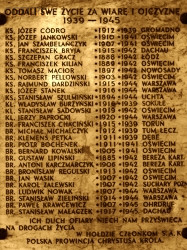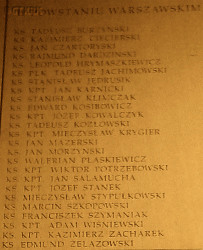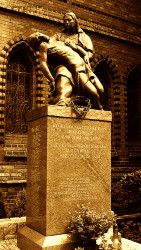Roman Catholic
St Sigismund parish
05-507 Słomczyn
85 Wiślana Str.
Konstancin deanery
Warsaw archdiocese, Poland
full list:
displayClick to display full list

searchClick to search full list by categories
wyświetlKliknij by wyświetlić pełną listę po polsku

szukajKliknij by przeszukać listę wg kategorii po polsku

Martyrology of the clergy — Poland
XX century (1914 – 1989)
personal data
religious status
blessed
surname
STANEK
forename(s)
Joseph (pl. Józef)
beatification date
13.06.1999more on
www.swzygmunt.knc.pl
[access: 2013.05.19]

the RC Pope John Paul IImore on
en.wikipedia.org
[access: 2014.09.21]
function
religious cleric
creed
Latin (Roman Catholic) Church RCmore on
en.wikipedia.org
[access: 2014.09.21]
congregation
Society of the Catholic Apostolate SACmore on
en.wikipedia.org
[access: 2013.05.19]
(i.e. Pallottines)
diocese / province
Christ the King province SACmore on
waw.pallotyni.pl
[access: 2019.02.02]
RC Military Ordinariate of Polandmore on
en.wikipedia.org
[access: 2014.12.20]
honorary titles
Gold „Cross of Military Chaplain”more on
Gold „Cross of Military Chaplain”
(13.05.2000)
date and place
of death
23.09.1944

Warsawtoday: Warsaw city pov., Masovia voiv., Poland
more on
en.wikipedia.org
[access: 2021.10.09]
details of death
After German invasion of Poland on 01.09.1939 (Russians invaded Poland 17 days later) and start of the World War II left on 07.09.1939, together with all friars the Society’s house in Ołarzew, and went alongside thousands of refugees east.
There overtaken by Russian invasion.
Arrested by the Russians but escaped.
Managed to get back to the German occupation zone and through family home n. Nowy Targ returned to Ołtarzew — then already under German occupation, in German‐run Germ. Generalgouvernement (Eng. General Governorate).
After completing Society’s theology studies in 1942 entered clandestine sociology lectures at Warsaw University (part of large educational effort of the Polish Clandestine State — Germans formally closed the universities treating Poles as second class nation able only for physical work).
Residing in Ołtarzew, during frequent trips to Warsaw for clandestine lectures, transported food for the starving inhabitants of Warsaw.
Ministered as chaplain of the clandestine Home Army AK (also part of Polish Clandestine State), before and during Warsaw Uprising.
The day of the outbreak of Uprising, 01.08.1944, found him in Warsaw, in Congregation of Franciscan Sisters of the Family of Mary's Institute CSFFM at Hoża Str. Since then ministered as the chaplain of fighting Warsaw, of nearby field hospitals in particular.
On 15.08.1944 became a chief chaplain of insurgents' „Kryska” Grouping of Home Army AK, fighting in and around Czerniakowska Str. area in Powiśle district, and at the same time its paramedic support, under nom‐de‐guerre „Rudy” (Eng. „Red‐hair”).
In Grouping HQ at Wilanowska Str. set–up a field chapel.
Tended to the wounded, supported civilian population.
Helped in field hospitals.
In 09.1944 passed on the opportunity to cross to the other side of the Vistula river — where the Russians stood idly by — in a pontoon, giving up his slot to another insurgent.
After fall of the Czerniaków area on 23.09.1944 attempted to take on the role of a peace envoy.
Germans ignored this and apprehended him on 11/13 Wilanowska Str., treating as a hostage.
And next hanged him on his own priestly stole, shoe‐less — together with 13 other insurgents, including 5 nurses, at the back of „Społem” warehouses at 53 Solec Str., in the vicinity of the so‐called „death house”, where Germans shot or hung all its inhabitants (c. 200 people).
German were to shout: „Not the Jews, not English, but those in black clothes are the worst, they are evil”.
cause of death
mass murder
perpetrators
Germans
sites and events
Collective responsibility („Hostages”)Click to display the description, Warsaw UprisingClick to display the description, Secret educational systemClick to display the description, GeneralgouvernementClick to display the description, Ribbentrop‐MolotovClick to display the description, Pius XI's encyclicalsClick to display the description
date and place
of birth
04.12.1916

Łapsze Niżnetoday: Łapsze Niżne gm., Nowy Targ pov., Lesser Poland voiv., Poland
more on
en.wikipedia.org
[access: 2022.01.28]
parents
STANEK Joseph
🞲 ?, ? — 🕆 1923, ?

NOWAK Agnes
🞲 ?, ? — 🕆 1923, ?
baptism
05.12.1910

Łapsze Niżnetoday: Łapsze Niżne gm., Nowy Targ pov., Lesser Poland voiv., Poland
more on
en.wikipedia.org
[access: 2022.01.28]
St Quirinus the Bishop and Martyr RC church
religious vows
15.08.1937 (temporary)
presbyter (holy orders)
ordination
07.04.1941

Warsawtoday: Warsaw city pov., Masovia voiv., Poland
more on
en.wikipedia.org
[access: 2021.10.09]
St John the Baptist Martyrdom RC archcathedral churchmore on
pl.wikipedia.org
[access: 2014.11.14]
positions held
till 1944
friar — Ołtarzewtoday: Ożarów Mazowiecki gm., Warsaw‐west pov., Masovia voiv., Poland
more on
en.wikipedia.org
[access: 2022.07.18] ⋄ Society's house, Pallottines SAC
1942 – 1944
student — Warsawtoday: Warsaw city pov., Masovia voiv., Poland
more on
en.wikipedia.org
[access: 2021.10.09] ⋄ sociology, University of Warsaw [i.e. University of Warsaw (from 1945) / clandestine University (1939‐1945) / Joseph Piłsudski University (1935‐1939) / University of Warsaw (1915‐1935) / Imperial University of Warsaw (1870‐1915)] — on clandestine lecturers
1938 – 1942
student — Ołtarzewtoday: Ożarów Mazowiecki gm., Warsaw‐west pov., Masovia voiv., Poland
more on
en.wikipedia.org
[access: 2022.07.18] ⋄ theology, Theological Seminary, Pallottines SAC
1937 – 1938
student — Sucharytoday: Nakło nad Notecią gm., Nakło nad Notecią pov., Kuyavia‐Pomerania voiv., Poland
more on
en.wikipedia.org
[access: 2022.08.28] ⋄ philosophy, Theological Seminary, Pallottines SAC
1936 – 1937
novitiate — Sucharytoday: Nakło nad Notecią gm., Nakło nad Notecią pov., Kuyavia‐Pomerania voiv., Poland
more on
en.wikipedia.org
[access: 2022.08.28] ⋄ Society's house, Pallottines SAC — also: student of philosophy at Theological Seminary
1935 – 1936
novitiate — Klecza Dolnatoday: Wadowice gm., Wadowice pov., Lesser Poland voiv., Poland
more on
en.wikipedia.org
[access: 2021.12.18] ⋄ Society's house („On the Mound”), Pallottines SAC — robed on 15.08.1935
1935
accession — Klecza Dolnatoday: Wadowice gm., Wadowice pov., Lesser Poland voiv., Poland
more on
en.wikipedia.org
[access: 2021.12.18] ⋄ Society's house („On the Mound”), Pallottines SAC
sites and events
descriptions
Collective responsibility („Hostages”): A criminal practice implemented by the Germans in the occupied territories of Poland, applied from the very first day of World War II. At its core was an appointment and public announcement of a list of names of selected people whose lives depended on absolute compliance with German orders. Any violation of these ordinances, by any person, regardless of the circumstances, resulted in the murder of the designated „hostages”. In the first days of the war and occupation, it was used i.a. by the German Wehrmacht army to prevent acts of continuation of the defense by the Poles. Later, especially in the German‐run General Governorate, it was part of the official policy of the occupation authorities — collective responsibility for any acts of resistance to the occupier's practices. For the life of one German, even if death was due to customary reasons, the Germans carried out executions from a dozen to even a hundred Poles previously designated as „hostages”.
Warsaw Uprising: Lasted from 01.08.1944 till 03.10.1944. Was an attempt to liberate Polish capital from occupying Germans by the Polish Clandestine State — a unique in the history of the world political structure on the territories occupied by the Germans, effectively governing clandestinely in Poland — and by fighting on its behalf underground military units, mainly of Home Army (former Armed Struggle Association ZWZ) and National Armed Forced (NSZ). At the same time Russians stopped on purpose the offensive on all front, halted on the other bank of Vistula river and watched calmly the annihilation of the city, refusing even the mid‐landing rights to the Allied planes carrying weapons and supplies to the insurgents from Italy. During the Uprising Germans murdered approx. 200,000 Poles, mainly civilians. Approx. 200 priests and nuns died in fighting or were murdered by the Germans, many in mass executions. (more on: en.wikipedia.orgClick to attempt to display webpage
[access: 2013.08.17])
Secret educational system: After the occupation began, the Germans started a ruthless fight against the Polish intelligentsia. The memorial issued on the basis of the guidelines of the German socialist leader, Adolf Hitler, was in force. It stated that in the occupied Polish territories: „Universities and other higher education institutions, vocational schools and secondary schools have always been centers of Polish chauvinistic upbringing and therefore should be closed altogether. Only elementary schools should be allowed, which should teach only the most primitive things: arithmetic, reading and writing. Education in nationally important subjects, such as geography, history, the history of literature, and gymnastics, must be banned”. Even religious education higher than elementary has become illegal. And in areas directly incorporated to Germany, e.g. Germ. Reichsgau Wartheland, the Germans went further — shut down all schools teaching in Polish, Hebrew and Yiddish. The resistance Polish Clandestine State created a secret education system. In 1944, over 100,000 young people studied in secret high schools, and several thousand in secret universities (e.g. the University of Warsaw, the University of Western Territories, the Jagiellonian University, the John Casimir University in Lviv. Secret teaching was ruthlessly combated by the German occupation authorities ‐ in 1939‐ 1945 8,500 Polish teachers lost their lives. (more on: en.wikipedia.orgClick to attempt to display webpage
[access: 2022.11.29])
Generalgouvernement: After the Polish defeat in the 09.1939 campaign, which was the result of the Ribbentrop‐Molotov Pact and constituted the first stage of World War II, and the beginning of German occupation in part of Poland (in the other, eastern part of Poland, the Russian occupation began), the Germans divided the occupied Polish territory into five main regions. In two of them new German provinces were created, two other were incorporated into other provinces. However, the fifth part was treated separately, and in a political sense it was supposed to recreate the German idea from 1915 (during World War I, after the defeat of the Russians in the Battle of Gorlice in 05.1915) of creating a Polish enclave within Germany. Illegal in the sense of international law, i.e. Hague Convention, and public law, managed by the Germans according to separate laws — especially established for the Polish Germ. Untermenschen (Eng. subhumans) — till the Russian offensive in 1945 it constituted part of the Germ. Großdeutschland (Eng. Greater Germany). Till 31.07.1940 formally called Germ. Generalgouvernement für die besetzten polnischen Gebiete (Eng. General Government for the occupied Polish lands) — later simply Germ. Generalgouvernement (Eng. General Governorate), as in the years 1915‐1918. From 07.1941, i.e. after the German attack on 22.06.1941 against the erstwhile ally, the Russians, it also included the Galicia district, i.e. the Polish pre‐war south‐eastern voivodeships. A special criminal law was enacted and applied to Poles and Jews, allowing for the arbitrary administration of the death penalty regardless of the age of the „perpetrator”, and sanctioning the use of collective responsibility. After the end of the military conflict of the World War UU, the government of the Germ. Generalgouvernement was recognized as a criminal organization, and its leader, governor Hans Frank, guilty of war crimes and crimes against humanity and executed. (more on: en.wikipedia.orgClick to attempt to display webpage
[access: 2024.12.13])
Ribbentrop‐Molotov: Genocidal Russian‐German alliance pact between Russian leader Joseph Stalin and German leader Adolf Hitler signed on 23.08.1939 in Moscow by respective foreign ministers, Mr. Vyacheslav Molotov for Russia and Joachim von Ribbentrop for Germany. The pact sanctioned and was the direct cause of joint Russian and German invasion of Poland and the outbreak of the World War II in 09.1939. In a political sense, the pact was an attempt to restore the status quo ante before 1914, with one exception, namely the „commercial” exchange of the so‐called „Kingdom of Poland”, which in 1914 was part of the Russian Empire, fore Eastern Galicia (today's western Ukraine), in 1914 belonging to the Austro‐Hungarian Empire. Galicia, including Lviv, was to be taken over by the Russians, the „Kingdom of Poland” — under the name of the General Governorate — Germany. The resultant „war was one of the greatest calamities and dramas of humanity in history, for two atheistic and anti‐Christian ideologies — national and international socialism — rejected God and His fifth Decalogue commandment: Thou shall not kill!” (Abp Stanislav Gądecki, 01.09.2019). The decisions taken — backed up by the betrayal of the formal allies of Poland, France and Germany, which on 12.09.1939, at a joint conference in Abbeville, decided not to provide aid to attacked Poland and not to take military action against Germany (a clear breach of treaty obligations with Poland) — were on 28.09.1939 slightly altered and made more precise when a treaty on „German‐Russian boundaries and friendship” was agreed by the same murderous signatories. One of its findings was establishment of spheres of influence in Central and Eastern Europe and in consequence IV partition of Poland. In one of its secret annexes agreed, that: „the Signatories will not tolerate on its respective territories any Polish propaganda that affects the territory of the other Side. On their respective territories they will suppress all such propaganda and inform each other of the measures taken to accomplish it”. The agreements resulted in a series of meeting between two genocidal organization representing both sides — German Gestapo and Russian NKVD when coordination of efforts to exterminate Polish intelligentsia and Polish leading classes (in Germany called «Intelligenzaktion», in Russia took the form of Katyń massacres) where discussed. Resulted in deaths of hundreds of thousands of Polish intelligentsia, including thousands of priests presented here, and tens of millions of ordinary people,. The results of this Russian‐German pact lasted till 1989 and are still in evidence even today. (more on: en.wikipedia.orgClick to attempt to display webpage
[access: 2015.09.30])
Pius XI's encyclicals: Facing the creation of two totalitarian systems in Europe, which seemed to compete with each other, though there were more similarities than contradictions between them, Pope Pius XI issued in 03.1937 (within 5 days) two encyclicals. In the „Mit brennender Sorge” (Eng. „With Burning Concern”) published on 14.03.1938, condemned the national socialism prevailing in Germany. The Pope wrote: „Whoever, following the old Germanic‐pre‐Christian beliefs, puts various impersonal fate in the place of a personal God, denies the wisdom of God and Providence […], whoever exalts earthly values: race or nation, or state, or state system, representatives of state power or other fundamental values of human society, […] and makes them the highest standard of all values, including religious ones, and idolizes them, this one […] is far from true faith in God and from a worldview corresponding to such faith”. On 19.03.1937, published „Divini Redemptoris” (Eng. „Divine Redeemer”), in which criticized Russian communism, dialectical materialism and the class struggle theory. The Pope wrote: „Communism deprives man of freedom, and therefore the spiritual basis of all life norms. It deprives the human person of all his dignity and any moral support with which he could resist the onslaught of blind passions […] This is the new gospel that Bolshevik and godless communism preaches as a message of salvation and redemption of humanity”… Pius XI demanded that the established human law be subjected to the natural law of God , recommended the implementation of the ideal of a Christian state and society, and called on Catholics to resist. Two years later, National Socialist Germany and Communist Russia came together and started World War II. (more on: www.vatican.vaClick to attempt to display webpage
[access: 2023.05.28], www.vatican.vaClick to attempt to display webpage
[access: 2023.05.28])
sources
personal:
swzygmunt.knc.plClick to attempt to display webpage
[access: 2012.11.23], wsdsac.plClick to attempt to display webpage
[access: 2012.12.28], www.pallotyni.plClick to attempt to display webpage
[access: 2013.07.06]
original images:
pallotti.fmClick to attempt to display webpage
[access: 2019.05.30], www.pallotynichelmno.euClick to attempt to display webpage
[access: 2019.05.30], www.pallotynichelmno.euClick to attempt to display webpage
[access: 2019.05.30], www.1944.plClick to attempt to display webpage
[access: 2019.05.30], brewiarz.plClick to attempt to display webpage
[access: 2019.05.30], mtrojnar.rzeszow.opoka.org.plClick to attempt to display webpage
[access: 2019.05.30], www.pallotynichelmno.euClick to attempt to display webpage
[access: 2019.05.30], commons.wikimedia.orgClick to attempt to display webpage
[access: 2019.05.30], www.1944.plClick to attempt to display webpage
[access: 2019.05.30], shdisk42.blogspot.comClick to attempt to display webpage
[access: 2019.05.30], www.zzw-niedzica.com.plClick to attempt to display webpage
[access: 2019.05.30], www.lapszenizne.plClick to attempt to display webpage
[access: 2019.05.30], meczennicy.waw.plClick to attempt to display webpage
[access: 2025.03.07], www.polskaniezwykla.plClick to attempt to display webpage
[access: 2014.01.16], skarbiecmazowiecki.plClick to attempt to display webpage
[access: 2013.12.04], www.miejscapamiecinarodowej.plClick to attempt to display webpage
[access: 2016.03.14], www.lapszenizne.plClick to attempt to display webpage
[access: 2019.05.30], www.1944.plClick to attempt to display webpage
[access: 2019.05.30], turystyka.ozarow-mazowiecki.plClick to attempt to display webpage
[access: 2017.11.07], www.katedrapolowa.plClick to attempt to display webpage
[access: 2014.01.16], www.szczecin.plClick to attempt to display webpage
[access: 2014.09.21]
LETTER to CUSTODIAN/ADMINISTRATOR
If you have an Email client on your communicator/computer — such as Mozilla Thunderbird, Windows Mail or Microsoft Outlook, described at WikipediaPatrz:
en.wikipedia.org, among others — try the link below, please:
LETTER to CUSTODIAN/ADMINISTRATORClick and try to call your own Email client
If however you do not run such a client or the above link is not active please send an email to the Custodian/Administrator using your account — in your customary email/correspondence engine — at the following address:

giving the following as the subject:
MARTYROLOGY: STANEK Joseph
To return to the biography press below:
 Click to return to biography
Click to return to biography































